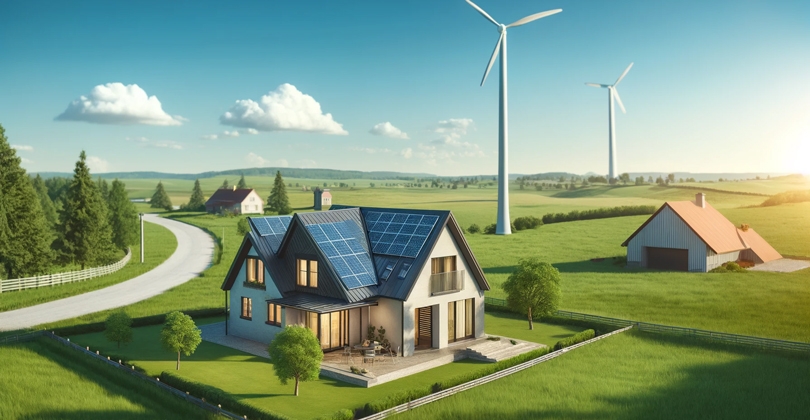Compared to wind energy, solar panels are the better choice for your home because solar provides a more predictable energy source, may cost less in the long-term, requires less space, and causes less disruption to the environment. We’ll walk you through the differences between wind power and solar power below.

Solar power vs. wind power: A comparison
Explore the chart below to quickly compare the benefits of solar power and wind power. Click on each metric in the left-hand column to learn more about each category.
| Metric | Solar Energy | Wind Energy |
| Power Generation | Powered by sunlight | Powered by wind |
| More predictable daily energy source than wind | Inconsistent power source | |
| Energy Efficiency | Generates energy in various weather conditions, including cloudy and sunny days | Requires wind speed of approximately 10 mph to generate energy |
| Cost | No up-front cost for qualified homeowners | Tax rebates and incentives increase affordability |
| Tax rebates and incentives increase affordability | Ongoing potential monthly electric bill savings | |
| Ongoing potential monthly electric bill savings | ||
| Location | Solar panels can be installed in densely populated areas | Best installed offshore than onshore |
| Panels require less space | Wind turbines require large, open areas | |
| Style | Solar panels seamlessly blend into roof | Bulky turbines can detract from curb appeal |
| Noise | Doesn’t produce sound when in use | May emit noise as blades move through air |
| Wildlife Impact | Doesn’t interfere with wildlife | Turbines are known to kill birds and bats |
How is the power generated?
Solar power generation
Solar panels generate power by harvesting the sun’s energy and converting it into usable electricity. Your solar panels can generate electricity on sunny and cloudy days, which means that they are constantly creating power for your home in daylight hours.
Wind power generation
Wind turbines generate power when the wind moves the blades, causing kinetic energy to flow into the generator connected to the turbine. The turbine then uses the kinetic energy to create electrical energy. Thus, you need a constant wind flow for wind turbines to produce electricity for your home.
Takeaway: Solar panels generate power more consistently because the sun typically shines more frequently than the wind blows at the speed needed.
Which power source is more efficient?
Solar energy efficiency
Most people think that solar panels are not a viable option if they live in a cloudy or cold area. However, even on cloudy days, the sun still shines and your panels still generate energy to power your home. Cold doesn’t affect solar production — the absence of light does!
Wind energy efficiency
Offshore wind turbines are technically the more efficient energy source when compared to solar power. However, these turbines need the perfect weather conditions (a consistent wind of approximately 10 mph) to successfully power your home, making solar panels more efficient on average.
Takeaway: Ultimately, wind may appear more efficient, but it’s only more efficient in the ideal weather conditions and location.

How has the cost of these renewable energy sources evolved?
Cost of solar
Initially, solar panels may seem like a huge financial investment. But thanks to tax incentives and our flexible financing, POWERHOME SOLAR makes the cost of solar energy more affordable than you might think. In fact, the cost of solar energy has decreased over 70% since 2010.
Cost of wind
Wind energy also qualifies for a production tax credit, which makes them more affordable for homeowners. Since the federal government extended the credit until the end of 2021, homeowners have more time to take advantage of this incentive.
Takeaway: Both solar panels and wind turbines offer tax rebates that reduce total costs for homeowners.
Where does each energy source work best?
Ideal location for solar power
Solar energy works in virtually any environment or location. All you need for solar panels is a clear enough angle to the sun so your panels are properly exposed. You can install them on all types of buildings, from apartment complexes to football stadiums.
- Style: Our sleek, black monocrystalline solar panels blend seamlessly into your roof so you can go solar without compromising curb appeal.
- Noise factor: Your solar panel system is a silent powerhouse that doesn’t make any noise when generating electricity, making them ideal for any property, especially homes.
- Wildlife: Solar panels help protect the environment and don’t disrupt the wildlife around your home.
Ideal location for wind power
Wind energy works best in large, open areas. The fact is, turbines are less compatible with residential properties because wind flow can be limited in neighborhoods and cities. That’s why they perform better when installed in open, offshore environments.
- Style: Wind turbines tend to be bulky and industrial in style—two terms you don’t typically associate with residential aesthetic. Because they are so large, turbines could detract from your overall curb appeal and property value
- Noise factor: Wind turbines create a lot of noise, which can disrupt your home and your neighborhood.
- Wildlife: Studies show that wind turbines can be hazardous to wildlife, especially flying animals such as birds and bats.
Takeaway: Solar panels are an ideal renewable energy source for your residential areas, while wind turbines work best in more open, less populated areas.
Is solar or wind the best choice for my home?
Ultimately, solar panels are the better renewable energy source for your home compared to wind turbines because they are more reliable at generating power in all conditions and more compatible with different property types. Visit our blog to learn about more financial and environmental benefits of solar energy that other renewable energy sources do not offer.
(1).png)
(1).png)